Marketing Strategy Report: Unilever's Analysis of the Global Market
VerifiedAdded on 2022/12/26
|15
|4496
|277
Report
AI Summary
This report provides a comprehensive analysis of Unilever's marketing strategies. It begins with an executive summary and introduction, followed by a PESTLE analysis examining the political, economic, social, technological, legal, and environmental factors impacting Unilever's global operations. A SWOT analysis evaluates the company's strengths, weaknesses, opportunities, and threats. The report then delves into Unilever's competitive advantages, focusing on product differentiation, branding, and pricing strategies. The second part of the report explores market segmentation, targeting, and positioning (STP) and recommends specific objectives and goals (SMART). Finally, it suggests marketing strategies based on the application of the marketing mix (7Ps), concluding with a summary of findings and recommendations.
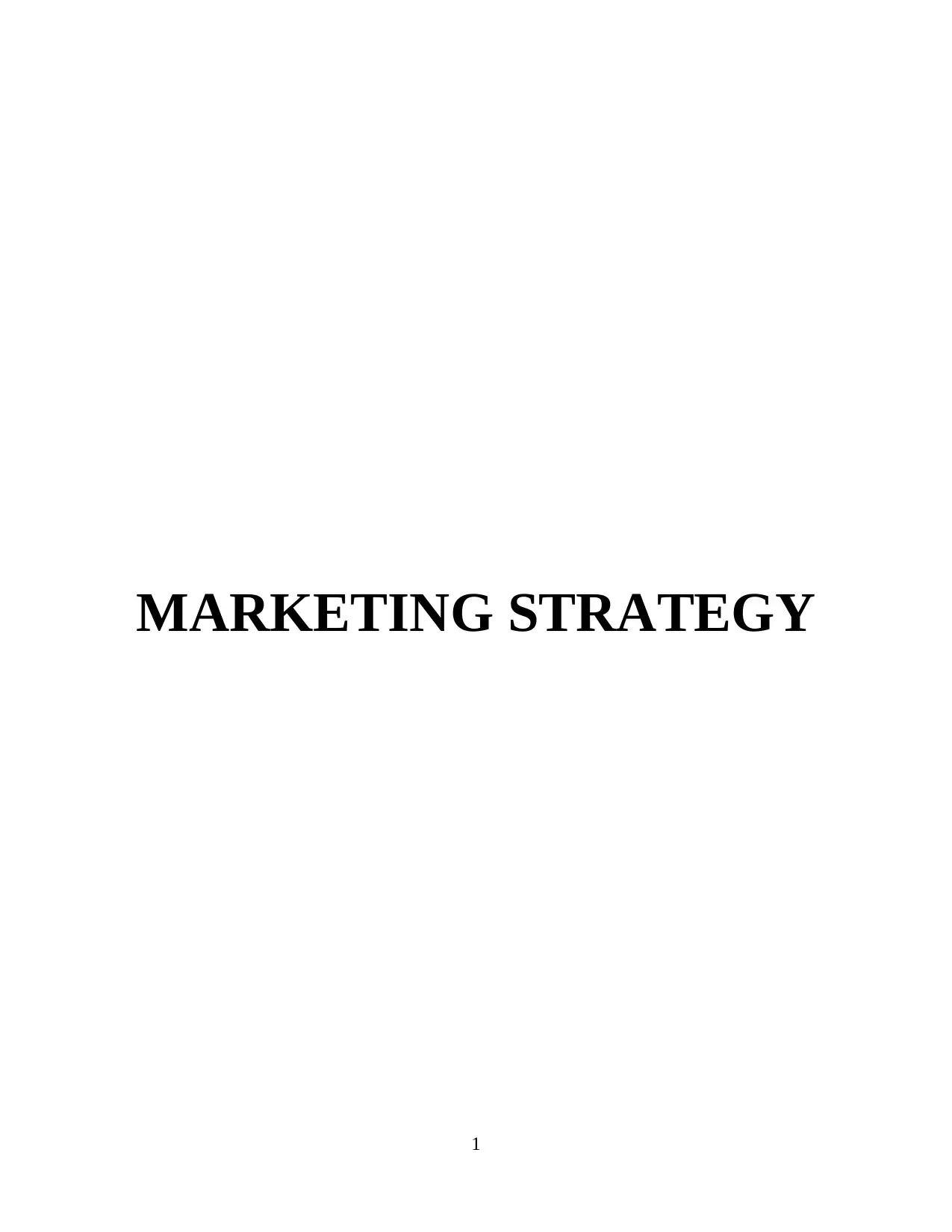
MARKETING STRATEGY
1
1
Paraphrase This Document
Need a fresh take? Get an instant paraphrase of this document with our AI Paraphraser

EXECUTIVE SUMMARY
Marketing is the important tool which used by business to develop and promote the goods
and services of the company. It used to develop products by analysing customer needs and
desires. In the context of Unilever which is an international organisation which renders its
services in the global market. It uses marketing mix to develop effective market offerings and
accomplish business success. Different marketing strategies used are 7P's of marketing to
promote the goods and services to the target customers.
2
Marketing is the important tool which used by business to develop and promote the goods
and services of the company. It used to develop products by analysing customer needs and
desires. In the context of Unilever which is an international organisation which renders its
services in the global market. It uses marketing mix to develop effective market offerings and
accomplish business success. Different marketing strategies used are 7P's of marketing to
promote the goods and services to the target customers.
2

Table of Contents
EXECUTIVE SUMMARY.............................................................................................................2
INTRODUCTION...........................................................................................................................4
PART 1............................................................................................................................................4
PESTLE Analysis on Unilever...............................................................................................4
SWOT analysis on Unilever ..................................................................................................6
Analyse and determine competitive advantage of Unilever ..................................................8
Determine current market strategies.....................................................................................10
PART 2..........................................................................................................................................11
Determine Market Segmentation Targeting & Positioning (STP).......................................11
Recommended objectives and goals for the choosing organisation (SMART) ..................12
Recommend marketing strategies, based on the application of the marketing mix for Unilever
..............................................................................................................................................12
CONCLUSION..............................................................................................................................14
REFERENCES..............................................................................................................................15
3
EXECUTIVE SUMMARY.............................................................................................................2
INTRODUCTION...........................................................................................................................4
PART 1............................................................................................................................................4
PESTLE Analysis on Unilever...............................................................................................4
SWOT analysis on Unilever ..................................................................................................6
Analyse and determine competitive advantage of Unilever ..................................................8
Determine current market strategies.....................................................................................10
PART 2..........................................................................................................................................11
Determine Market Segmentation Targeting & Positioning (STP).......................................11
Recommended objectives and goals for the choosing organisation (SMART) ..................12
Recommend marketing strategies, based on the application of the marketing mix for Unilever
..............................................................................................................................................12
CONCLUSION..............................................................................................................................14
REFERENCES..............................................................................................................................15
3
⊘ This is a preview!⊘
Do you want full access?
Subscribe today to unlock all pages.

Trusted by 1+ million students worldwide
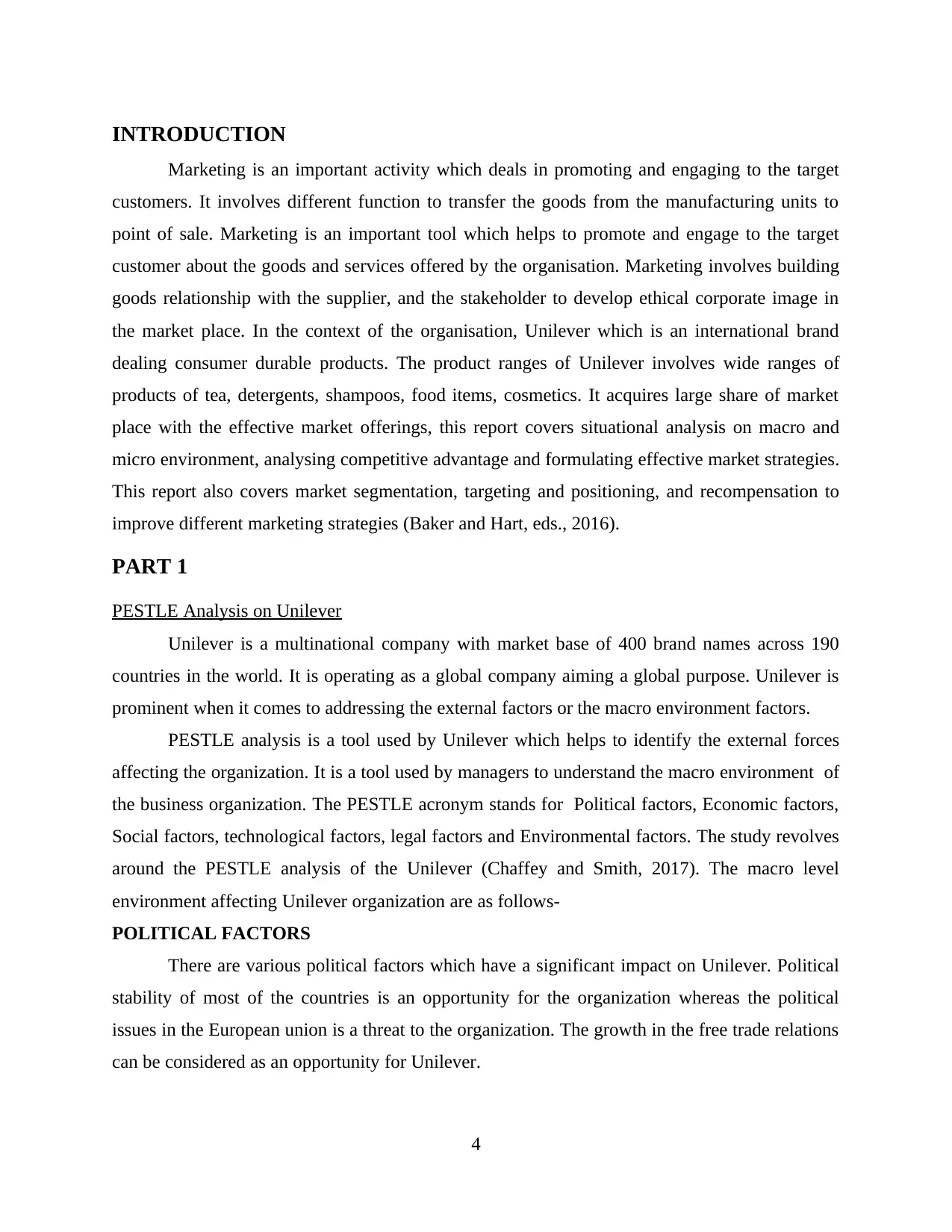
INTRODUCTION
Marketing is an important activity which deals in promoting and engaging to the target
customers. It involves different function to transfer the goods from the manufacturing units to
point of sale. Marketing is an important tool which helps to promote and engage to the target
customer about the goods and services offered by the organisation. Marketing involves building
goods relationship with the supplier, and the stakeholder to develop ethical corporate image in
the market place. In the context of the organisation, Unilever which is an international brand
dealing consumer durable products. The product ranges of Unilever involves wide ranges of
products of tea, detergents, shampoos, food items, cosmetics. It acquires large share of market
place with the effective market offerings, this report covers situational analysis on macro and
micro environment, analysing competitive advantage and formulating effective market strategies.
This report also covers market segmentation, targeting and positioning, and recompensation to
improve different marketing strategies (Baker and Hart, eds., 2016).
PART 1
PESTLE Analysis on Unilever
Unilever is a multinational company with market base of 400 brand names across 190
countries in the world. It is operating as a global company aiming a global purpose. Unilever is
prominent when it comes to addressing the external factors or the macro environment factors.
PESTLE analysis is a tool used by Unilever which helps to identify the external forces
affecting the organization. It is a tool used by managers to understand the macro environment of
the business organization. The PESTLE acronym stands for Political factors, Economic factors,
Social factors, technological factors, legal factors and Environmental factors. The study revolves
around the PESTLE analysis of the Unilever (Chaffey and Smith, 2017). The macro level
environment affecting Unilever organization are as follows-
POLITICAL FACTORS
There are various political factors which have a significant impact on Unilever. Political
stability of most of the countries is an opportunity for the organization whereas the political
issues in the European union is a threat to the organization. The growth in the free trade relations
can be considered as an opportunity for Unilever.
4
Marketing is an important activity which deals in promoting and engaging to the target
customers. It involves different function to transfer the goods from the manufacturing units to
point of sale. Marketing is an important tool which helps to promote and engage to the target
customer about the goods and services offered by the organisation. Marketing involves building
goods relationship with the supplier, and the stakeholder to develop ethical corporate image in
the market place. In the context of the organisation, Unilever which is an international brand
dealing consumer durable products. The product ranges of Unilever involves wide ranges of
products of tea, detergents, shampoos, food items, cosmetics. It acquires large share of market
place with the effective market offerings, this report covers situational analysis on macro and
micro environment, analysing competitive advantage and formulating effective market strategies.
This report also covers market segmentation, targeting and positioning, and recompensation to
improve different marketing strategies (Baker and Hart, eds., 2016).
PART 1
PESTLE Analysis on Unilever
Unilever is a multinational company with market base of 400 brand names across 190
countries in the world. It is operating as a global company aiming a global purpose. Unilever is
prominent when it comes to addressing the external factors or the macro environment factors.
PESTLE analysis is a tool used by Unilever which helps to identify the external forces
affecting the organization. It is a tool used by managers to understand the macro environment of
the business organization. The PESTLE acronym stands for Political factors, Economic factors,
Social factors, technological factors, legal factors and Environmental factors. The study revolves
around the PESTLE analysis of the Unilever (Chaffey and Smith, 2017). The macro level
environment affecting Unilever organization are as follows-
POLITICAL FACTORS
There are various political factors which have a significant impact on Unilever. Political
stability of most of the countries is an opportunity for the organization whereas the political
issues in the European union is a threat to the organization. The growth in the free trade relations
can be considered as an opportunity for Unilever.
4
Paraphrase This Document
Need a fresh take? Get an instant paraphrase of this document with our AI Paraphraser
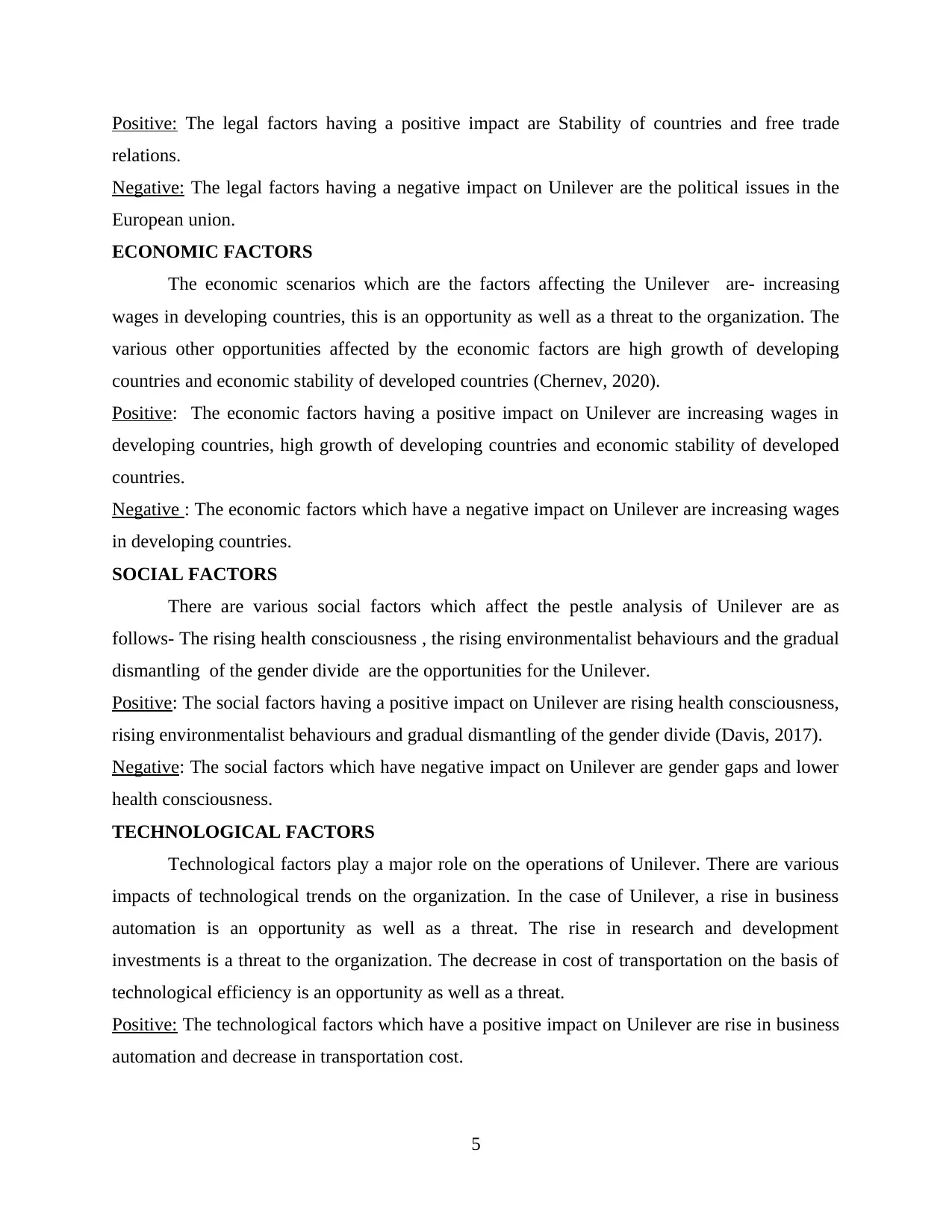
Positive: The legal factors having a positive impact are Stability of countries and free trade
relations.
Negative: The legal factors having a negative impact on Unilever are the political issues in the
European union.
ECONOMIC FACTORS
The economic scenarios which are the factors affecting the Unilever are- increasing
wages in developing countries, this is an opportunity as well as a threat to the organization. The
various other opportunities affected by the economic factors are high growth of developing
countries and economic stability of developed countries (Chernev, 2020).
Positive: The economic factors having a positive impact on Unilever are increasing wages in
developing countries, high growth of developing countries and economic stability of developed
countries.
Negative : The economic factors which have a negative impact on Unilever are increasing wages
in developing countries.
SOCIAL FACTORS
There are various social factors which affect the pestle analysis of Unilever are as
follows- The rising health consciousness , the rising environmentalist behaviours and the gradual
dismantling of the gender divide are the opportunities for the Unilever.
Positive: The social factors having a positive impact on Unilever are rising health consciousness,
rising environmentalist behaviours and gradual dismantling of the gender divide (Davis, 2017).
Negative: The social factors which have negative impact on Unilever are gender gaps and lower
health consciousness.
TECHNOLOGICAL FACTORS
Technological factors play a major role on the operations of Unilever. There are various
impacts of technological trends on the organization. In the case of Unilever, a rise in business
automation is an opportunity as well as a threat. The rise in research and development
investments is a threat to the organization. The decrease in cost of transportation on the basis of
technological efficiency is an opportunity as well as a threat.
Positive: The technological factors which have a positive impact on Unilever are rise in business
automation and decrease in transportation cost.
5
relations.
Negative: The legal factors having a negative impact on Unilever are the political issues in the
European union.
ECONOMIC FACTORS
The economic scenarios which are the factors affecting the Unilever are- increasing
wages in developing countries, this is an opportunity as well as a threat to the organization. The
various other opportunities affected by the economic factors are high growth of developing
countries and economic stability of developed countries (Chernev, 2020).
Positive: The economic factors having a positive impact on Unilever are increasing wages in
developing countries, high growth of developing countries and economic stability of developed
countries.
Negative : The economic factors which have a negative impact on Unilever are increasing wages
in developing countries.
SOCIAL FACTORS
There are various social factors which affect the pestle analysis of Unilever are as
follows- The rising health consciousness , the rising environmentalist behaviours and the gradual
dismantling of the gender divide are the opportunities for the Unilever.
Positive: The social factors having a positive impact on Unilever are rising health consciousness,
rising environmentalist behaviours and gradual dismantling of the gender divide (Davis, 2017).
Negative: The social factors which have negative impact on Unilever are gender gaps and lower
health consciousness.
TECHNOLOGICAL FACTORS
Technological factors play a major role on the operations of Unilever. There are various
impacts of technological trends on the organization. In the case of Unilever, a rise in business
automation is an opportunity as well as a threat. The rise in research and development
investments is a threat to the organization. The decrease in cost of transportation on the basis of
technological efficiency is an opportunity as well as a threat.
Positive: The technological factors which have a positive impact on Unilever are rise in business
automation and decrease in transportation cost.
5
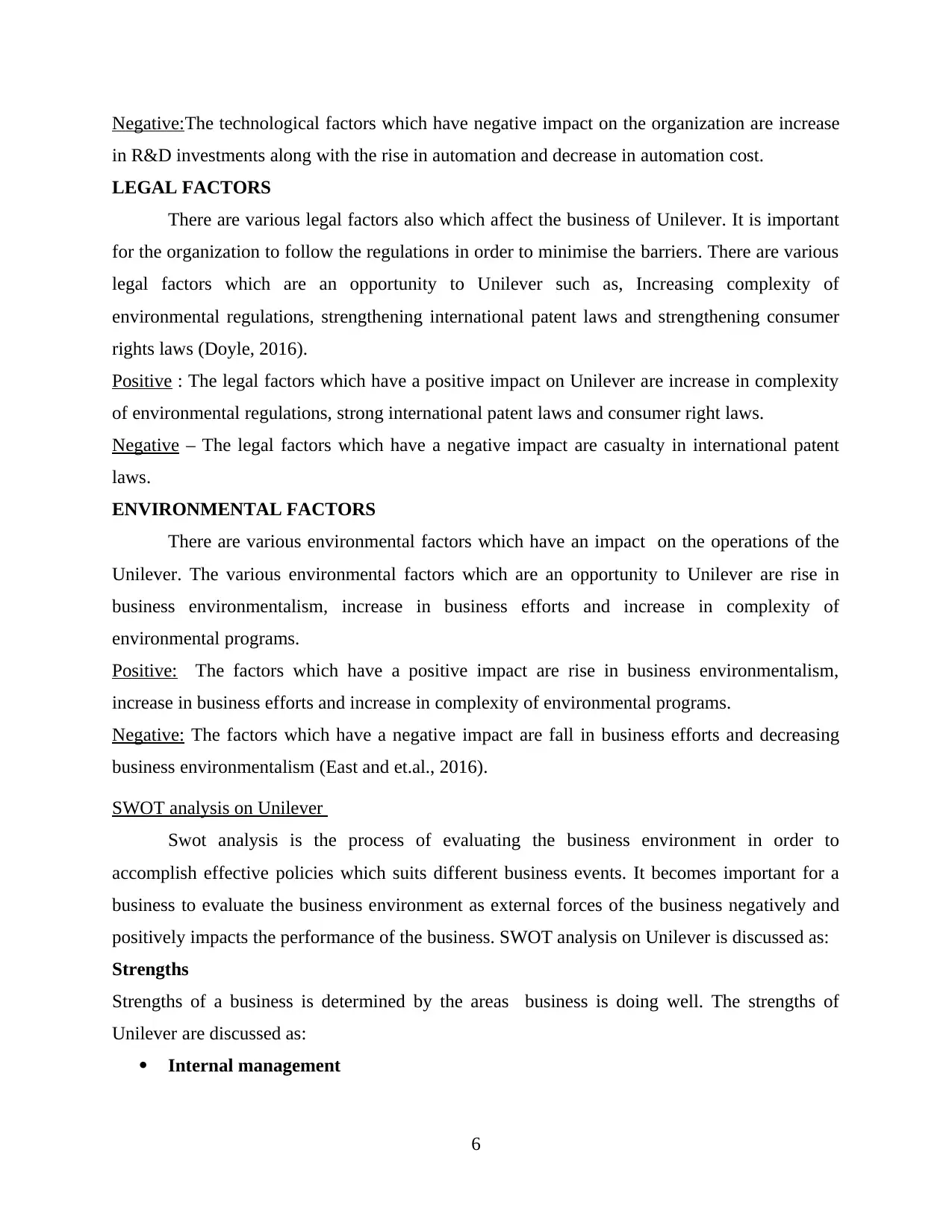
Negative:The technological factors which have negative impact on the organization are increase
in R&D investments along with the rise in automation and decrease in automation cost.
LEGAL FACTORS
There are various legal factors also which affect the business of Unilever. It is important
for the organization to follow the regulations in order to minimise the barriers. There are various
legal factors which are an opportunity to Unilever such as, Increasing complexity of
environmental regulations, strengthening international patent laws and strengthening consumer
rights laws (Doyle, 2016).
Positive : The legal factors which have a positive impact on Unilever are increase in complexity
of environmental regulations, strong international patent laws and consumer right laws.
Negative – The legal factors which have a negative impact are casualty in international patent
laws.
ENVIRONMENTAL FACTORS
There are various environmental factors which have an impact on the operations of the
Unilever. The various environmental factors which are an opportunity to Unilever are rise in
business environmentalism, increase in business efforts and increase in complexity of
environmental programs.
Positive: The factors which have a positive impact are rise in business environmentalism,
increase in business efforts and increase in complexity of environmental programs.
Negative: The factors which have a negative impact are fall in business efforts and decreasing
business environmentalism (East and et.al., 2016).
SWOT analysis on Unilever
Swot analysis is the process of evaluating the business environment in order to
accomplish effective policies which suits different business events. It becomes important for a
business to evaluate the business environment as external forces of the business negatively and
positively impacts the performance of the business. SWOT analysis on Unilever is discussed as:
Strengths
Strengths of a business is determined by the areas business is doing well. The strengths of
Unilever are discussed as:
Internal management
6
in R&D investments along with the rise in automation and decrease in automation cost.
LEGAL FACTORS
There are various legal factors also which affect the business of Unilever. It is important
for the organization to follow the regulations in order to minimise the barriers. There are various
legal factors which are an opportunity to Unilever such as, Increasing complexity of
environmental regulations, strengthening international patent laws and strengthening consumer
rights laws (Doyle, 2016).
Positive : The legal factors which have a positive impact on Unilever are increase in complexity
of environmental regulations, strong international patent laws and consumer right laws.
Negative – The legal factors which have a negative impact are casualty in international patent
laws.
ENVIRONMENTAL FACTORS
There are various environmental factors which have an impact on the operations of the
Unilever. The various environmental factors which are an opportunity to Unilever are rise in
business environmentalism, increase in business efforts and increase in complexity of
environmental programs.
Positive: The factors which have a positive impact are rise in business environmentalism,
increase in business efforts and increase in complexity of environmental programs.
Negative: The factors which have a negative impact are fall in business efforts and decreasing
business environmentalism (East and et.al., 2016).
SWOT analysis on Unilever
Swot analysis is the process of evaluating the business environment in order to
accomplish effective policies which suits different business events. It becomes important for a
business to evaluate the business environment as external forces of the business negatively and
positively impacts the performance of the business. SWOT analysis on Unilever is discussed as:
Strengths
Strengths of a business is determined by the areas business is doing well. The strengths of
Unilever are discussed as:
Internal management
6
⊘ This is a preview!⊘
Do you want full access?
Subscribe today to unlock all pages.

Trusted by 1+ million students worldwide

Unilever follows the hierarchical structure which involves top level executives, middle level
managers and employees. Top level executives formulates different business policies and long
term planning in order to develop and determine business objectives. The middle level managers
implements the plans and policies of the top level management and executives it accomplish the
business objective. Manager delegates different job roles to the employees and monitors the
performances of the employees to achieve organisational objectives (Frost and Strauss, 2016).
Strong brand image
Unilever has strong brand image in the market place, which helps to accomplish large market
share and achieve the profit share gaols of the company. With strong brand image, it helps to
connects the large number of the target customer and develop strong consumer perception.
Economies to scale
Economies to scale is achieved when the business produces goods in the bulk. Unilever promotes
manufacturing of goods in large quantity which helps to achieve economies to scale in the
production function. Economies to scale reduces the cost of production which contributes to the
profitability of the business.
Weakness
Weaknesses is determined by the grey areas where the business is not doing well. The
weaknesses of Unilever are discussed below:
Imitable products
Unilever offers products which are often similar in the market. It does not come up with new
products and services in the market which impacts the sales margin of the company. Customers
find the similar products from different competitors which negatively impacts the objectives of
business.
Dependence on retailer
Unilever depends on the retailer for marketing is product and services to the end customers. It
becomes very difficult to judge whether the retailer is putting efforts for selling the products of
the company. Unilever depends too much other retailers for selling product and services of the
company (Gillespie, 2015).
Opportunities
7
managers and employees. Top level executives formulates different business policies and long
term planning in order to develop and determine business objectives. The middle level managers
implements the plans and policies of the top level management and executives it accomplish the
business objective. Manager delegates different job roles to the employees and monitors the
performances of the employees to achieve organisational objectives (Frost and Strauss, 2016).
Strong brand image
Unilever has strong brand image in the market place, which helps to accomplish large market
share and achieve the profit share gaols of the company. With strong brand image, it helps to
connects the large number of the target customer and develop strong consumer perception.
Economies to scale
Economies to scale is achieved when the business produces goods in the bulk. Unilever promotes
manufacturing of goods in large quantity which helps to achieve economies to scale in the
production function. Economies to scale reduces the cost of production which contributes to the
profitability of the business.
Weakness
Weaknesses is determined by the grey areas where the business is not doing well. The
weaknesses of Unilever are discussed below:
Imitable products
Unilever offers products which are often similar in the market. It does not come up with new
products and services in the market which impacts the sales margin of the company. Customers
find the similar products from different competitors which negatively impacts the objectives of
business.
Dependence on retailer
Unilever depends on the retailer for marketing is product and services to the end customers. It
becomes very difficult to judge whether the retailer is putting efforts for selling the products of
the company. Unilever depends too much other retailers for selling product and services of the
company (Gillespie, 2015).
Opportunities
7
Paraphrase This Document
Need a fresh take? Get an instant paraphrase of this document with our AI Paraphraser

Opportunities of the business is determined by external business environment. Business
should evaluate these opportunities formulate business plans and policies in order to adopt them
in business practices. Opportunities of Unilever are discussed below:
Large customer base
Due to the global market of Unilever, it acquires large customers base it helps to accomplish
sales margin and profit goals to accomplish business objectives.
Business enhancement for developing eco friendly products
Unilever has concurrently engaged in developing products which are environmental friendly in
nature. It is the recent advertisement is has brought the ad campaign for developing all the ranges
of product which environment friendly in nature. By the end of 2025, it would produce goods
which contributes to environment protection (Groucutt and Hopkins, 2015).
Threats
The Brexit has impacted trades of Unilever in the following way:
High taxes of production for raw materials
Due Brexit, the rates of raw materials are higher and the tax levied on the raw materials which
burden the cost of production and further adds to expenses of the company.
Import and export
Brexit have negatively impacted the export and import activities of Unilever due to high taxes
levied on export and import of the company and the restrictions imposed on the activities of have
affected the performance of business.
Analyse and determine competitive advantage of Unilever
Unique selling proposition is the distinctive offerings in the products and services which
attracts customers by attractive market offerings. Unique selling proposition defines that how the
product are different from the competitors, when the product is different in the market it attracts
customers take services from company. Unilever develop effective market offerings to attract
customers to taking the services of company (Hanssens and Pauwels, 2016).
Product differentiation
Product differentiation is the technique followed by Unilever to differentiate the product
and services offered by the company from its competitors. Research and development
department of Unilever regenerate new product ideas by analysing the needs and demands of the
8
should evaluate these opportunities formulate business plans and policies in order to adopt them
in business practices. Opportunities of Unilever are discussed below:
Large customer base
Due to the global market of Unilever, it acquires large customers base it helps to accomplish
sales margin and profit goals to accomplish business objectives.
Business enhancement for developing eco friendly products
Unilever has concurrently engaged in developing products which are environmental friendly in
nature. It is the recent advertisement is has brought the ad campaign for developing all the ranges
of product which environment friendly in nature. By the end of 2025, it would produce goods
which contributes to environment protection (Groucutt and Hopkins, 2015).
Threats
The Brexit has impacted trades of Unilever in the following way:
High taxes of production for raw materials
Due Brexit, the rates of raw materials are higher and the tax levied on the raw materials which
burden the cost of production and further adds to expenses of the company.
Import and export
Brexit have negatively impacted the export and import activities of Unilever due to high taxes
levied on export and import of the company and the restrictions imposed on the activities of have
affected the performance of business.
Analyse and determine competitive advantage of Unilever
Unique selling proposition is the distinctive offerings in the products and services which
attracts customers by attractive market offerings. Unique selling proposition defines that how the
product are different from the competitors, when the product is different in the market it attracts
customers take services from company. Unilever develop effective market offerings to attract
customers to taking the services of company (Hanssens and Pauwels, 2016).
Product differentiation
Product differentiation is the technique followed by Unilever to differentiate the product
and services offered by the company from its competitors. Research and development
department of Unilever regenerate new product ideas by analysing the needs and demands of the
8
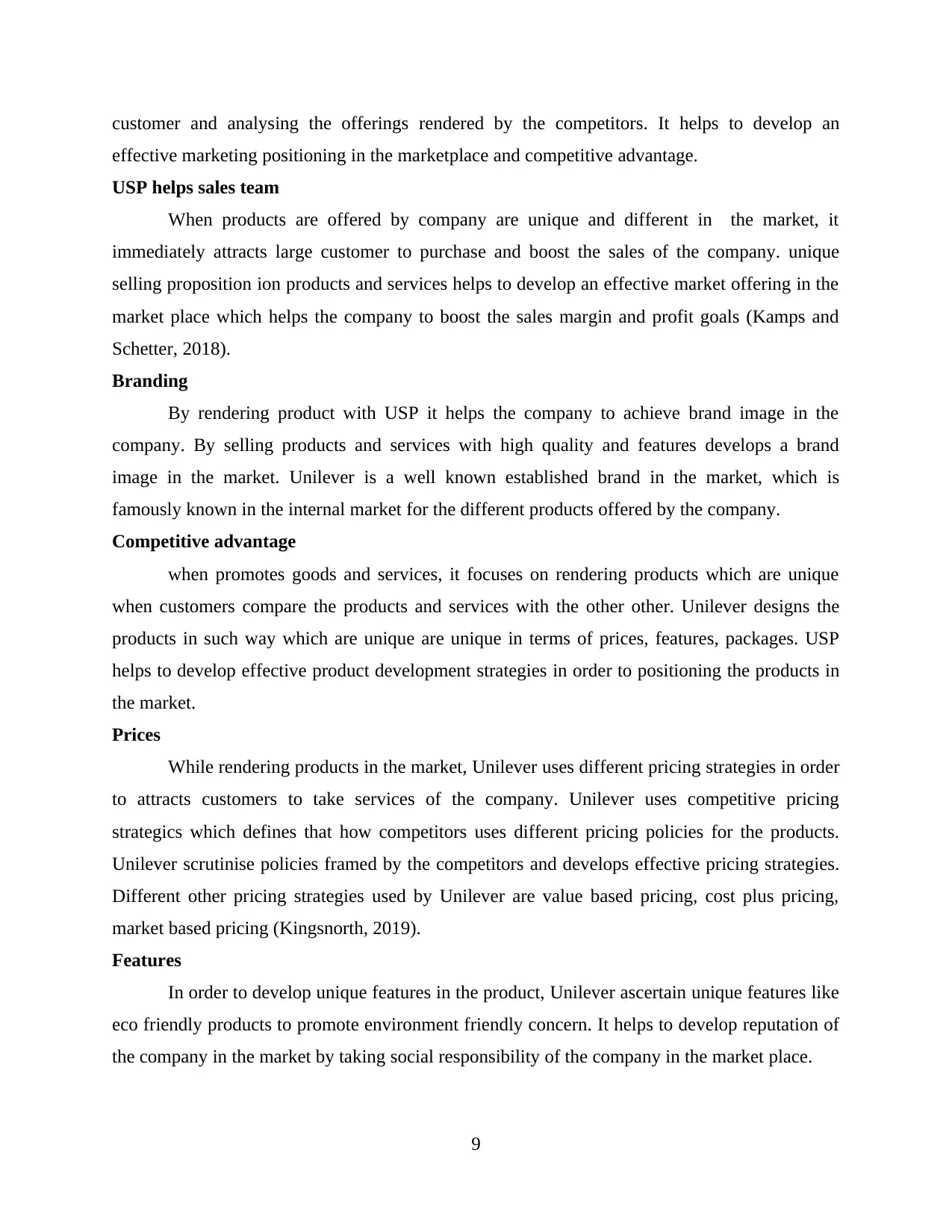
customer and analysing the offerings rendered by the competitors. It helps to develop an
effective marketing positioning in the marketplace and competitive advantage.
USP helps sales team
When products are offered by company are unique and different in the market, it
immediately attracts large customer to purchase and boost the sales of the company. unique
selling proposition ion products and services helps to develop an effective market offering in the
market place which helps the company to boost the sales margin and profit goals (Kamps and
Schetter, 2018).
Branding
By rendering product with USP it helps the company to achieve brand image in the
company. By selling products and services with high quality and features develops a brand
image in the market. Unilever is a well known established brand in the market, which is
famously known in the internal market for the different products offered by the company.
Competitive advantage
when promotes goods and services, it focuses on rendering products which are unique
when customers compare the products and services with the other other. Unilever designs the
products in such way which are unique are unique in terms of prices, features, packages. USP
helps to develop effective product development strategies in order to positioning the products in
the market.
Prices
While rendering products in the market, Unilever uses different pricing strategies in order
to attracts customers to take services of the company. Unilever uses competitive pricing
strategics which defines that how competitors uses different pricing policies for the products.
Unilever scrutinise policies framed by the competitors and develops effective pricing strategies.
Different other pricing strategies used by Unilever are value based pricing, cost plus pricing,
market based pricing (Kingsnorth, 2019).
Features
In order to develop unique features in the product, Unilever ascertain unique features like
eco friendly products to promote environment friendly concern. It helps to develop reputation of
the company in the market by taking social responsibility of the company in the market place.
9
effective marketing positioning in the marketplace and competitive advantage.
USP helps sales team
When products are offered by company are unique and different in the market, it
immediately attracts large customer to purchase and boost the sales of the company. unique
selling proposition ion products and services helps to develop an effective market offering in the
market place which helps the company to boost the sales margin and profit goals (Kamps and
Schetter, 2018).
Branding
By rendering product with USP it helps the company to achieve brand image in the
company. By selling products and services with high quality and features develops a brand
image in the market. Unilever is a well known established brand in the market, which is
famously known in the internal market for the different products offered by the company.
Competitive advantage
when promotes goods and services, it focuses on rendering products which are unique
when customers compare the products and services with the other other. Unilever designs the
products in such way which are unique are unique in terms of prices, features, packages. USP
helps to develop effective product development strategies in order to positioning the products in
the market.
Prices
While rendering products in the market, Unilever uses different pricing strategies in order
to attracts customers to take services of the company. Unilever uses competitive pricing
strategics which defines that how competitors uses different pricing policies for the products.
Unilever scrutinise policies framed by the competitors and develops effective pricing strategies.
Different other pricing strategies used by Unilever are value based pricing, cost plus pricing,
market based pricing (Kingsnorth, 2019).
Features
In order to develop unique features in the product, Unilever ascertain unique features like
eco friendly products to promote environment friendly concern. It helps to develop reputation of
the company in the market by taking social responsibility of the company in the market place.
9
⊘ This is a preview!⊘
Do you want full access?
Subscribe today to unlock all pages.

Trusted by 1+ million students worldwide
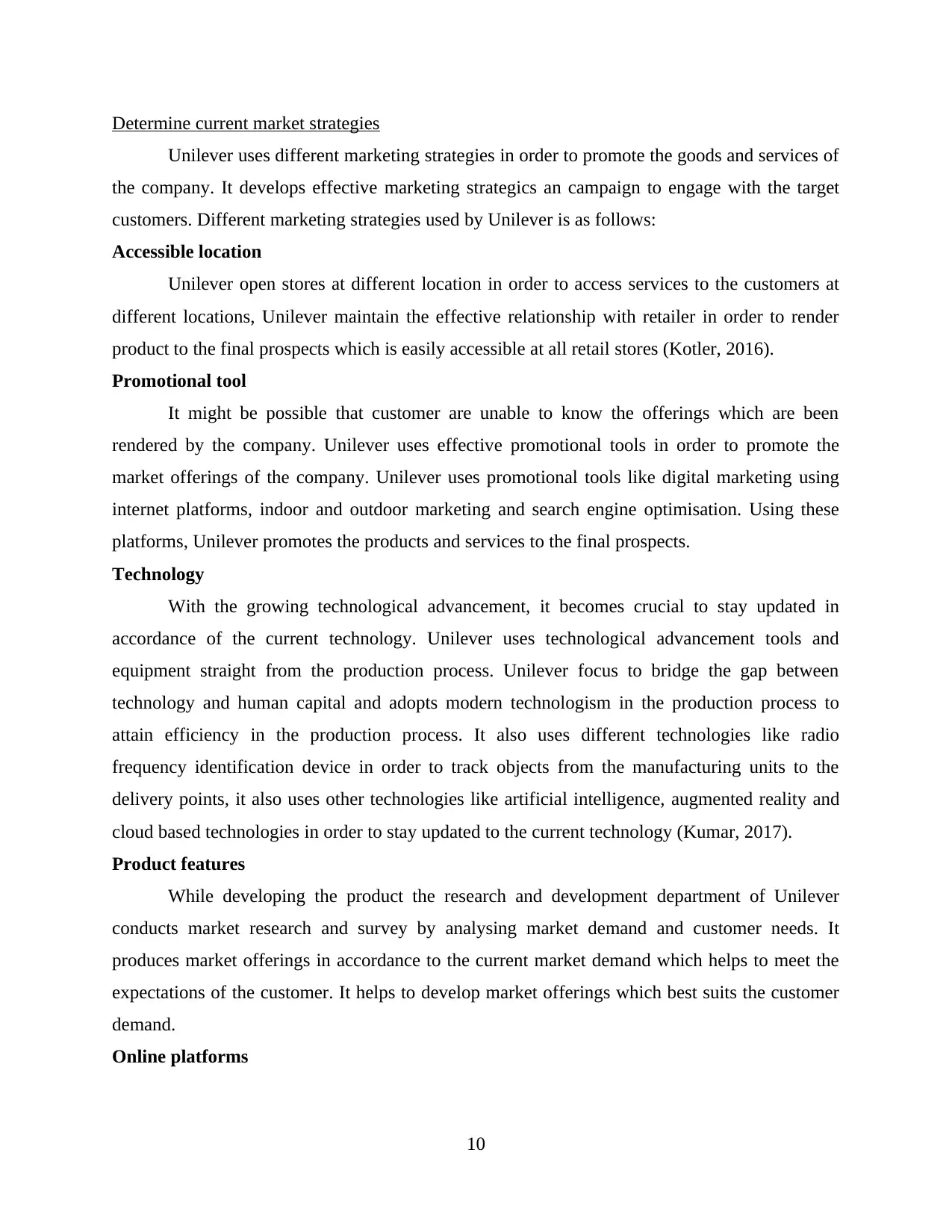
Determine current market strategies
Unilever uses different marketing strategies in order to promote the goods and services of
the company. It develops effective marketing strategics an campaign to engage with the target
customers. Different marketing strategies used by Unilever is as follows:
Accessible location
Unilever open stores at different location in order to access services to the customers at
different locations, Unilever maintain the effective relationship with retailer in order to render
product to the final prospects which is easily accessible at all retail stores (Kotler, 2016).
Promotional tool
It might be possible that customer are unable to know the offerings which are been
rendered by the company. Unilever uses effective promotional tools in order to promote the
market offerings of the company. Unilever uses promotional tools like digital marketing using
internet platforms, indoor and outdoor marketing and search engine optimisation. Using these
platforms, Unilever promotes the products and services to the final prospects.
Technology
With the growing technological advancement, it becomes crucial to stay updated in
accordance of the current technology. Unilever uses technological advancement tools and
equipment straight from the production process. Unilever focus to bridge the gap between
technology and human capital and adopts modern technologism in the production process to
attain efficiency in the production process. It also uses different technologies like radio
frequency identification device in order to track objects from the manufacturing units to the
delivery points, it also uses other technologies like artificial intelligence, augmented reality and
cloud based technologies in order to stay updated to the current technology (Kumar, 2017).
Product features
While developing the product the research and development department of Unilever
conducts market research and survey by analysing market demand and customer needs. It
produces market offerings in accordance to the current market demand which helps to meet the
expectations of the customer. It helps to develop market offerings which best suits the customer
demand.
Online platforms
10
Unilever uses different marketing strategies in order to promote the goods and services of
the company. It develops effective marketing strategics an campaign to engage with the target
customers. Different marketing strategies used by Unilever is as follows:
Accessible location
Unilever open stores at different location in order to access services to the customers at
different locations, Unilever maintain the effective relationship with retailer in order to render
product to the final prospects which is easily accessible at all retail stores (Kotler, 2016).
Promotional tool
It might be possible that customer are unable to know the offerings which are been
rendered by the company. Unilever uses effective promotional tools in order to promote the
market offerings of the company. Unilever uses promotional tools like digital marketing using
internet platforms, indoor and outdoor marketing and search engine optimisation. Using these
platforms, Unilever promotes the products and services to the final prospects.
Technology
With the growing technological advancement, it becomes crucial to stay updated in
accordance of the current technology. Unilever uses technological advancement tools and
equipment straight from the production process. Unilever focus to bridge the gap between
technology and human capital and adopts modern technologism in the production process to
attain efficiency in the production process. It also uses different technologies like radio
frequency identification device in order to track objects from the manufacturing units to the
delivery points, it also uses other technologies like artificial intelligence, augmented reality and
cloud based technologies in order to stay updated to the current technology (Kumar, 2017).
Product features
While developing the product the research and development department of Unilever
conducts market research and survey by analysing market demand and customer needs. It
produces market offerings in accordance to the current market demand which helps to meet the
expectations of the customer. It helps to develop market offerings which best suits the customer
demand.
Online platforms
10
Paraphrase This Document
Need a fresh take? Get an instant paraphrase of this document with our AI Paraphraser
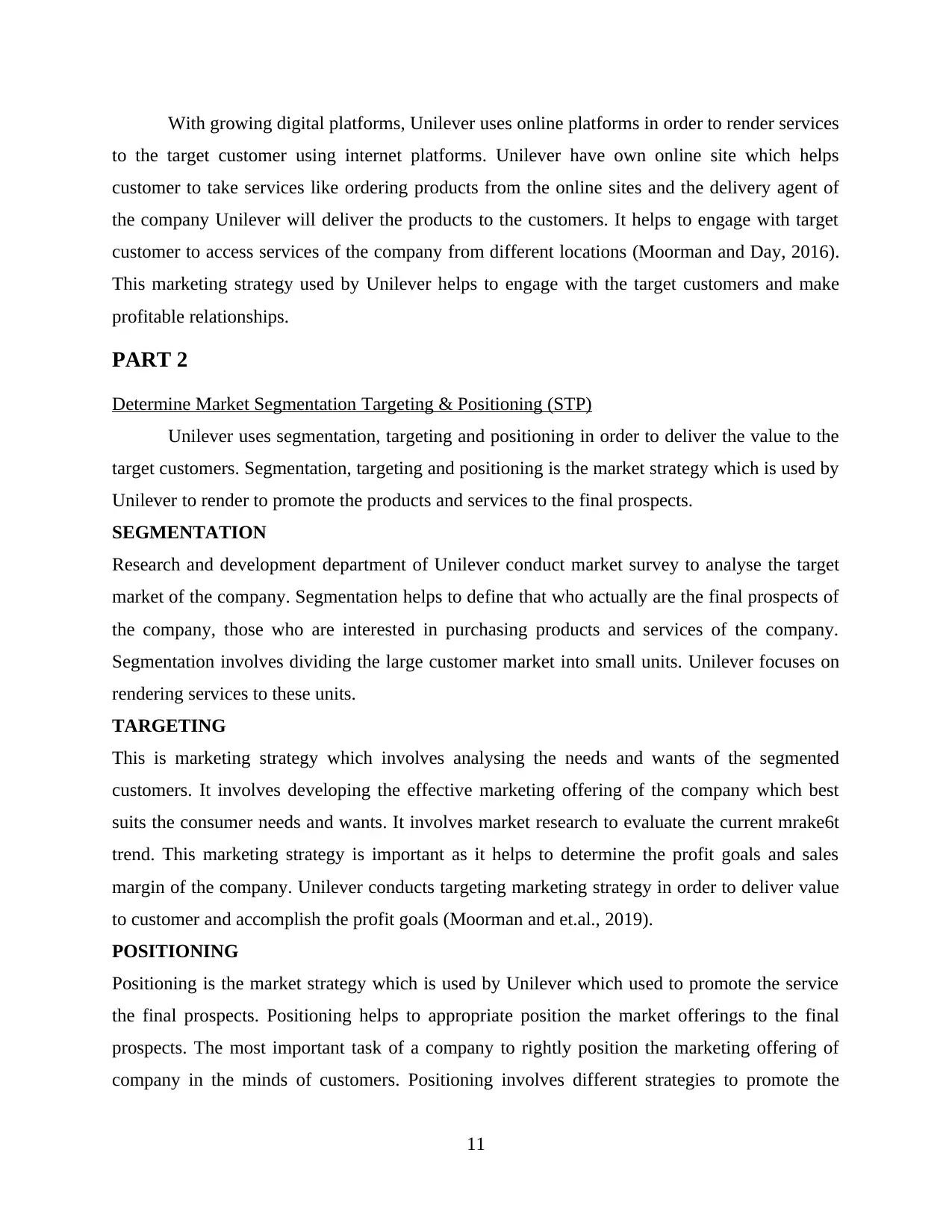
With growing digital platforms, Unilever uses online platforms in order to render services
to the target customer using internet platforms. Unilever have own online site which helps
customer to take services like ordering products from the online sites and the delivery agent of
the company Unilever will deliver the products to the customers. It helps to engage with target
customer to access services of the company from different locations (Moorman and Day, 2016).
This marketing strategy used by Unilever helps to engage with the target customers and make
profitable relationships.
PART 2
Determine Market Segmentation Targeting & Positioning (STP)
Unilever uses segmentation, targeting and positioning in order to deliver the value to the
target customers. Segmentation, targeting and positioning is the market strategy which is used by
Unilever to render to promote the products and services to the final prospects.
SEGMENTATION
Research and development department of Unilever conduct market survey to analyse the target
market of the company. Segmentation helps to define that who actually are the final prospects of
the company, those who are interested in purchasing products and services of the company.
Segmentation involves dividing the large customer market into small units. Unilever focuses on
rendering services to these units.
TARGETING
This is marketing strategy which involves analysing the needs and wants of the segmented
customers. It involves developing the effective marketing offering of the company which best
suits the consumer needs and wants. It involves market research to evaluate the current mrake6t
trend. This marketing strategy is important as it helps to determine the profit goals and sales
margin of the company. Unilever conducts targeting marketing strategy in order to deliver value
to customer and accomplish the profit goals (Moorman and et.al., 2019).
POSITIONING
Positioning is the market strategy which is used by Unilever which used to promote the service
the final prospects. Positioning helps to appropriate position the market offerings to the final
prospects. The most important task of a company to rightly position the marketing offering of
company in the minds of customers. Positioning involves different strategies to promote the
11
to the target customer using internet platforms. Unilever have own online site which helps
customer to take services like ordering products from the online sites and the delivery agent of
the company Unilever will deliver the products to the customers. It helps to engage with target
customer to access services of the company from different locations (Moorman and Day, 2016).
This marketing strategy used by Unilever helps to engage with the target customers and make
profitable relationships.
PART 2
Determine Market Segmentation Targeting & Positioning (STP)
Unilever uses segmentation, targeting and positioning in order to deliver the value to the
target customers. Segmentation, targeting and positioning is the market strategy which is used by
Unilever to render to promote the products and services to the final prospects.
SEGMENTATION
Research and development department of Unilever conduct market survey to analyse the target
market of the company. Segmentation helps to define that who actually are the final prospects of
the company, those who are interested in purchasing products and services of the company.
Segmentation involves dividing the large customer market into small units. Unilever focuses on
rendering services to these units.
TARGETING
This is marketing strategy which involves analysing the needs and wants of the segmented
customers. It involves developing the effective marketing offering of the company which best
suits the consumer needs and wants. It involves market research to evaluate the current mrake6t
trend. This marketing strategy is important as it helps to determine the profit goals and sales
margin of the company. Unilever conducts targeting marketing strategy in order to deliver value
to customer and accomplish the profit goals (Moorman and et.al., 2019).
POSITIONING
Positioning is the market strategy which is used by Unilever which used to promote the service
the final prospects. Positioning helps to appropriate position the market offerings to the final
prospects. The most important task of a company to rightly position the marketing offering of
company in the minds of customers. Positioning involves different strategies to promote the
11
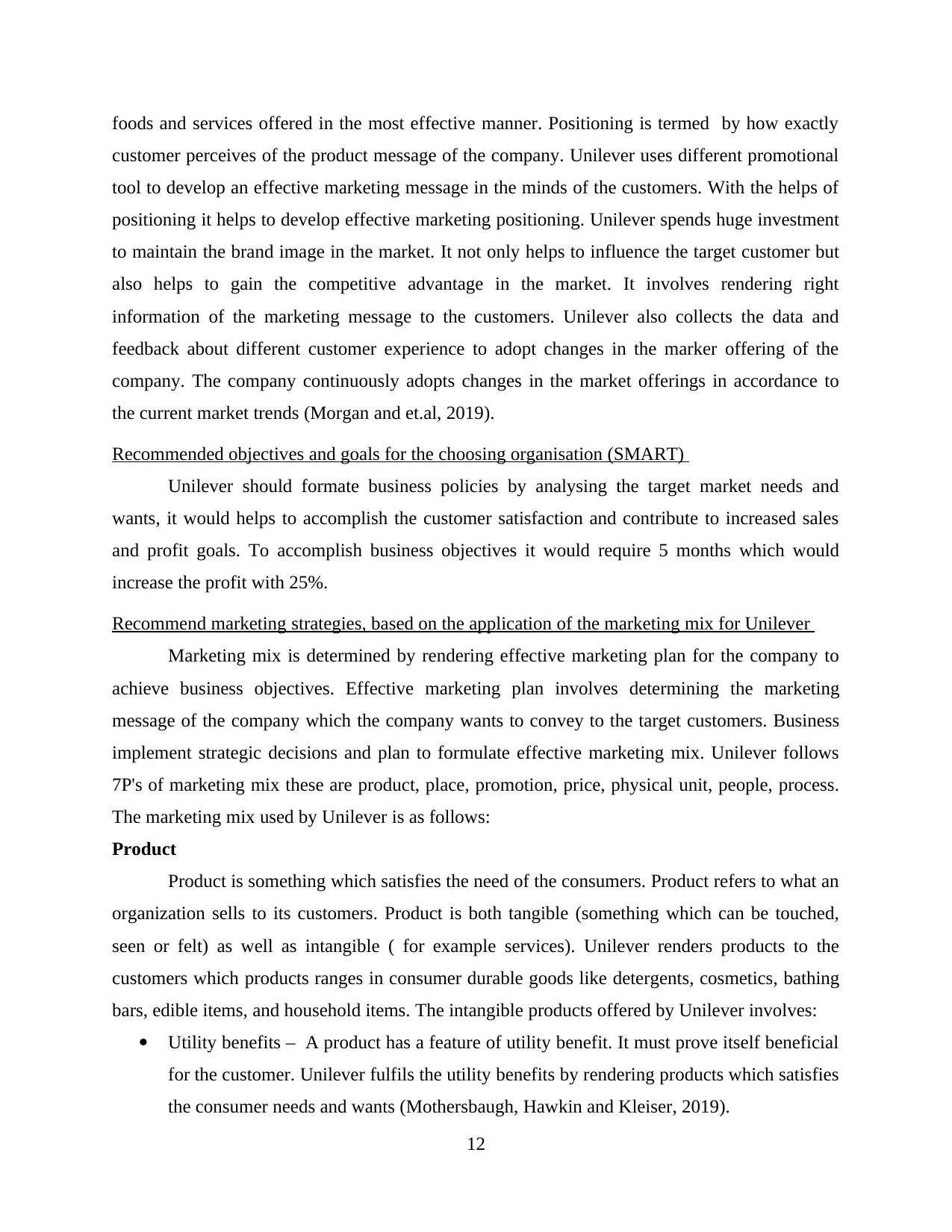
foods and services offered in the most effective manner. Positioning is termed by how exactly
customer perceives of the product message of the company. Unilever uses different promotional
tool to develop an effective marketing message in the minds of the customers. With the helps of
positioning it helps to develop effective marketing positioning. Unilever spends huge investment
to maintain the brand image in the market. It not only helps to influence the target customer but
also helps to gain the competitive advantage in the market. It involves rendering right
information of the marketing message to the customers. Unilever also collects the data and
feedback about different customer experience to adopt changes in the marker offering of the
company. The company continuously adopts changes in the market offerings in accordance to
the current market trends (Morgan and et.al, 2019).
Recommended objectives and goals for the choosing organisation (SMART)
Unilever should formate business policies by analysing the target market needs and
wants, it would helps to accomplish the customer satisfaction and contribute to increased sales
and profit goals. To accomplish business objectives it would require 5 months which would
increase the profit with 25%.
Recommend marketing strategies, based on the application of the marketing mix for Unilever
Marketing mix is determined by rendering effective marketing plan for the company to
achieve business objectives. Effective marketing plan involves determining the marketing
message of the company which the company wants to convey to the target customers. Business
implement strategic decisions and plan to formulate effective marketing mix. Unilever follows
7P's of marketing mix these are product, place, promotion, price, physical unit, people, process.
The marketing mix used by Unilever is as follows:
Product
Product is something which satisfies the need of the consumers. Product refers to what an
organization sells to its customers. Product is both tangible (something which can be touched,
seen or felt) as well as intangible ( for example services). Unilever renders products to the
customers which products ranges in consumer durable goods like detergents, cosmetics, bathing
bars, edible items, and household items. The intangible products offered by Unilever involves:
Utility benefits – A product has a feature of utility benefit. It must prove itself beneficial
for the customer. Unilever fulfils the utility benefits by rendering products which satisfies
the consumer needs and wants (Mothersbaugh, Hawkin and Kleiser, 2019).
12
customer perceives of the product message of the company. Unilever uses different promotional
tool to develop an effective marketing message in the minds of the customers. With the helps of
positioning it helps to develop effective marketing positioning. Unilever spends huge investment
to maintain the brand image in the market. It not only helps to influence the target customer but
also helps to gain the competitive advantage in the market. It involves rendering right
information of the marketing message to the customers. Unilever also collects the data and
feedback about different customer experience to adopt changes in the marker offering of the
company. The company continuously adopts changes in the market offerings in accordance to
the current market trends (Morgan and et.al, 2019).
Recommended objectives and goals for the choosing organisation (SMART)
Unilever should formate business policies by analysing the target market needs and
wants, it would helps to accomplish the customer satisfaction and contribute to increased sales
and profit goals. To accomplish business objectives it would require 5 months which would
increase the profit with 25%.
Recommend marketing strategies, based on the application of the marketing mix for Unilever
Marketing mix is determined by rendering effective marketing plan for the company to
achieve business objectives. Effective marketing plan involves determining the marketing
message of the company which the company wants to convey to the target customers. Business
implement strategic decisions and plan to formulate effective marketing mix. Unilever follows
7P's of marketing mix these are product, place, promotion, price, physical unit, people, process.
The marketing mix used by Unilever is as follows:
Product
Product is something which satisfies the need of the consumers. Product refers to what an
organization sells to its customers. Product is both tangible (something which can be touched,
seen or felt) as well as intangible ( for example services). Unilever renders products to the
customers which products ranges in consumer durable goods like detergents, cosmetics, bathing
bars, edible items, and household items. The intangible products offered by Unilever involves:
Utility benefits – A product has a feature of utility benefit. It must prove itself beneficial
for the customer. Unilever fulfils the utility benefits by rendering products which satisfies
the consumer needs and wants (Mothersbaugh, Hawkin and Kleiser, 2019).
12
⊘ This is a preview!⊘
Do you want full access?
Subscribe today to unlock all pages.

Trusted by 1+ million students worldwide
1 out of 15
Related Documents
Your All-in-One AI-Powered Toolkit for Academic Success.
+13062052269
info@desklib.com
Available 24*7 on WhatsApp / Email
![[object Object]](/_next/static/media/star-bottom.7253800d.svg)
Unlock your academic potential
Copyright © 2020–2025 A2Z Services. All Rights Reserved. Developed and managed by ZUCOL.





